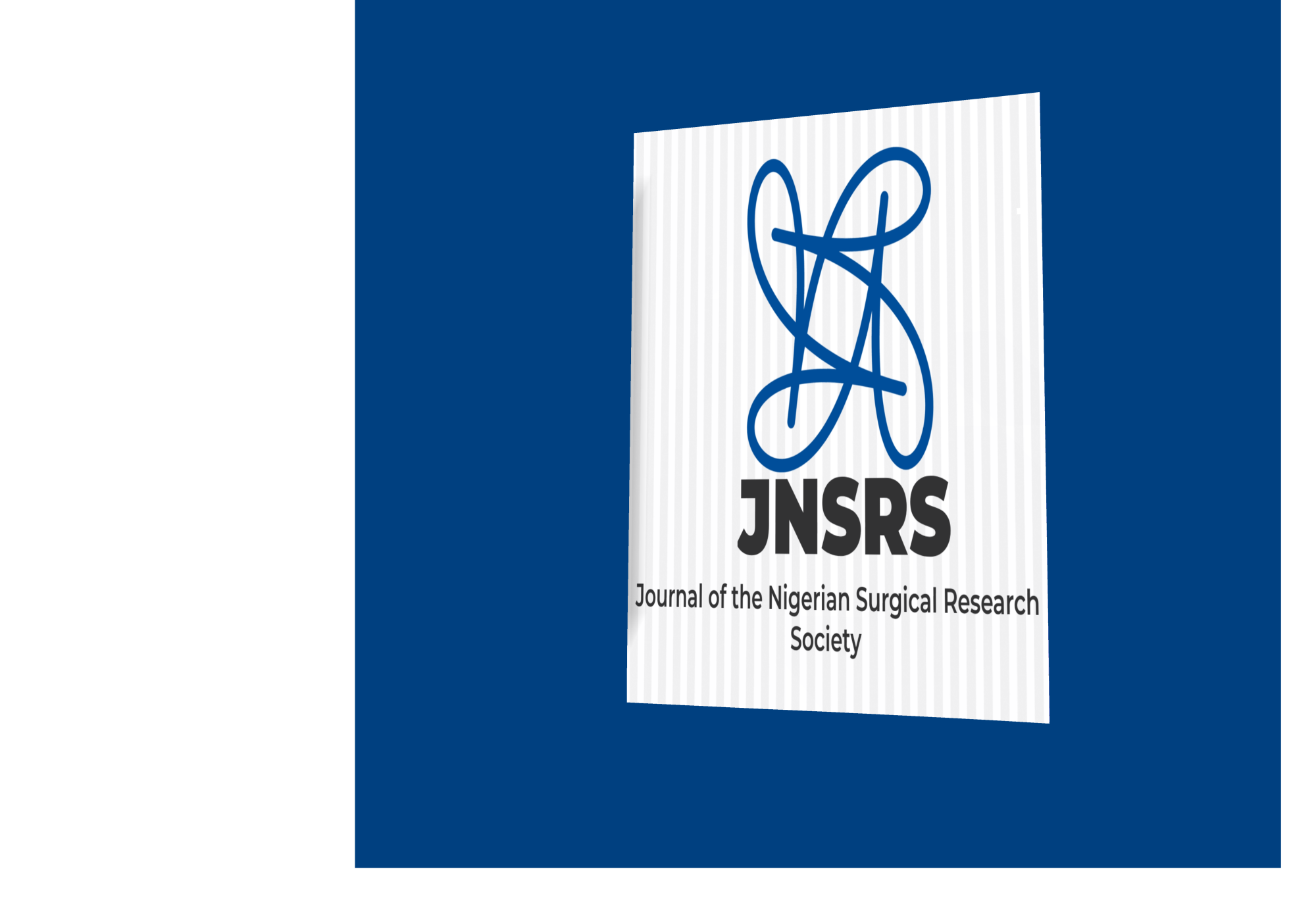Comparing tissue adhesive (2-octylcyanoacrylate) to subcuticular vicryl 3/0 skin closure following excision of benign breast masses
Keywords:
Benign breast lumps, octylcyanoacrylates, wound closure.Abstract
Background: Most breast lumps occur in females. They are a course of anxiety because of the fear of cancer and the distortion of the shape of the affected breast. Most women wish to remove such lumps but are also anxious about the resulting scar on their breast. The final arbiter for the optimal management of breast lumps is histology. This involves a biopsy which often requires an incision and consequently, a surgical scar. Several studies comparing various methods of skin closure after open biopsy, and illustrating varying cosmetic results have been reported. However, there is paucity of such studies on breast surgery in our environment.
Aim: This study compared 2-octylcyanoacrylate (OCA) and vicryl 3/0 subcuticular skin closure following excision of palpable benign breast lumps in terms of cosmetic outcomes, wound complication and patient satisfaction.
Methodology: This was a prospective randomised controlled study in which 70 patients were randomly allocated for skin closure of their wounds with either OCA or vicryl 3/0 subcuticular wound closure following breast lump excision biopsy. Cosmetic outcome was assessed using the Hollander wound evaluation scale (HWES) and the visual analogue scale (VAS). Wound management and complication rates, and patients’ satisfaction were also compared. Data was collated and analysed using the statistical package for the social sciences (SPSS) version 23.
Results: A total of 67 patients completed the study and the outcome of 71 wounds was analysed: n = 34 for the tissue adhesive group (OCA) and n = 37 for the vicryl group (SVC). There was no statistically significant difference in age distribution, or educational status between both groups. Both groups had similar cosmetic outcomes when assessed using the Hollander wound evaluation scale (P=0.535) and visual analogue scale (P=0.232) with no statistically significant difference found between both groups. Similarly, patients’ satisfaction and wound complication rates were the same, but OCA had a statistically significant faster skin closure time when compared to SVC (p=0.000).
CONCLUSION
The use of OCA did not give superior cosmetic results following excision of benign breast lumps when compared to SVC but was found to have a faster skin closure. OCA also had similar wound complication rates and thus can be incorporated into the practice of wound closure in our environment.
References
Ibrahim IM,Iliyasu Y, Mohammed AZ. Histopathological review of breast tumours in Kano, Northern Nigeria. Sub-saharan Afri J Med. 2015;2:47-51
Forae GD, Nwachokor TN, Igbe AP, Odukuma EI, Ijomona EA. Benign breast diseases in Warri, Southern Nigeria ; A spectrum of histopathological analysis. Ann Nig Med. 2014;8:28-31
Yusuf LM, Odigie VI, Mohammed A. Breast masses in Zaria Nigeria. Ann Afr Med. 2003;2(1):13-16
Azuibuike SO, Muirhead C, Heyesh MC, Nelly R. Rising global burden of breast cancer: the case of sub-saharan Africa (with emphasis on Nigeria) and implications for regional development, a review. World J Surg Oncol. 2018;16(1):63
Akhator A. Benign breast masses in Nigeria. Niger J Surg Sci. 2017;17(2):105-108
Bruncicardi FC, Andersen DK, Billiar TR. Schwartz’s principles of surgery. 10th ed. Newyork (US): McGraw-Hill Education; 2014.p507
Adhikary S, Sood S, Dhugel K, Rajbanshi S, Shakya V, Khaniya S. Endoscopic excision of a fibroadenoma of the breast ;Transaxillary approach. Kathamandu Univ Med J. 2012;38(2):106-108
Hasdamir P.S, Guvenal T, Ozcakir HT, Koyuncu FM, Horasan GD, Erkan M, et al. Comparison of subcuticular suture materials in caeseran skin closure. Surg Res Pract. 2015; 2-5.
Shotria S. The periareolar incision. A gateway to the breast. Eur J S Oncol. 2001;27(6):601-603
Dawson CC, Gilliam AD,Speake WJ, Lobo DN, Becckingham IJ. A prospective randomised controlled trial comparing n-butyl cyanoacrylate tissue adhesive (liquiband) with sutures for skin closure after laparoscopic general surgical procedures. Surg Laparosc Endosc Percutan Tech. 2006;16:146-150
Singer AJ, Thadu HC. A review of the literature on octylcyanoacrylate tissue adhesive. Am J Surg. 2004;187:238-248
Singer AJ, Quinn JV, Hollander JE. The cyanoacrylate topical skin adhesives. AM J Emerg Med. 2008;26:490-96
Umoke IC, Olori S, Garba ES. Tissue adhesive (2-octylcyanoacrylate) versus standard wound closure in breast lump excision. Edorium J Surg. 2019;6:1-5
Gennari R, Rotmenz N, Ballardini B, Scevola S, Perago E, Zanini V et al. A prospective randomised controlled trial of tissue adhesives (2-octylcyanoacrylate) versus standard wound closure in breast surgery. Surgery. 2004;136(3):553-9
Velnar T, Bailey T, Smrkolj V. The wound healing process; an overview of the cellular and molecular mechanisms. J Int Med Res. 2009;37:1528-42
Quinn JV, Wells GA. An assessment of clinical wound evaluation scales. Academic Emergency Medicine. 1998;5:583-586.
Dinakar D, Ellor S, Joseph V. A randomised trial comparing octylcyanoacrylate tissueadhesive and suture in the management of facial lacerations. Eur J Plast Surg. 2019;42:597-602
Gottrup F, Melling A, Hollander DA. An overview of surgical site infection and aethiology , incidence and risk factors. EMWA. 2005;5(2):11-15.
Quinn JV, Draewieki A, Stiell IG, Elmslie TJ. Appearance scales to measure cosmetic outcomes of healed lacerations. Am J Emerg Med. 1995;13:229-31
Freeman KH, Reynolds MW, Vaughn BB, Hart JC. Patient outcomes associated with 2-octylcyanoacrylate topical skin adhesive in coronary artery bypass graft surgery. Surg Infect. 2011;12:307-16
Martin JG, Hollenbeck ST, Janas G, Makar RA, Dabon – Ramos WM, Suhocki PV, et al. Randomised controlled trial of octyl cyanoacrylate skin adhesive versus subcuticular sutures for skin closure after implantable venous port placement. J Vasc Interv Radiol. 2017;28:111-116
Hall LT, Bailes JE. Using dermabond for wound closure in lumbar and cervical neurosurgical procedures. Neurosurgery.2005;56:147-150
Downloads
Published
Issue
Section
License
Copyright (c) 2024 Journal of the Nigerian Surgical Research Society

This work is licensed under a Creative Commons Attribution-NonCommercial-ShareAlike 4.0 International License.
This is an open-access article distributed under the terms of the Creative Commons Attribution-Non Commercial-Share Alike 4.0 License, which allows others to remix, tweak, and build upon the work non-commercially, as long as the author is credited and the new creations are licensed under the identical terms.




